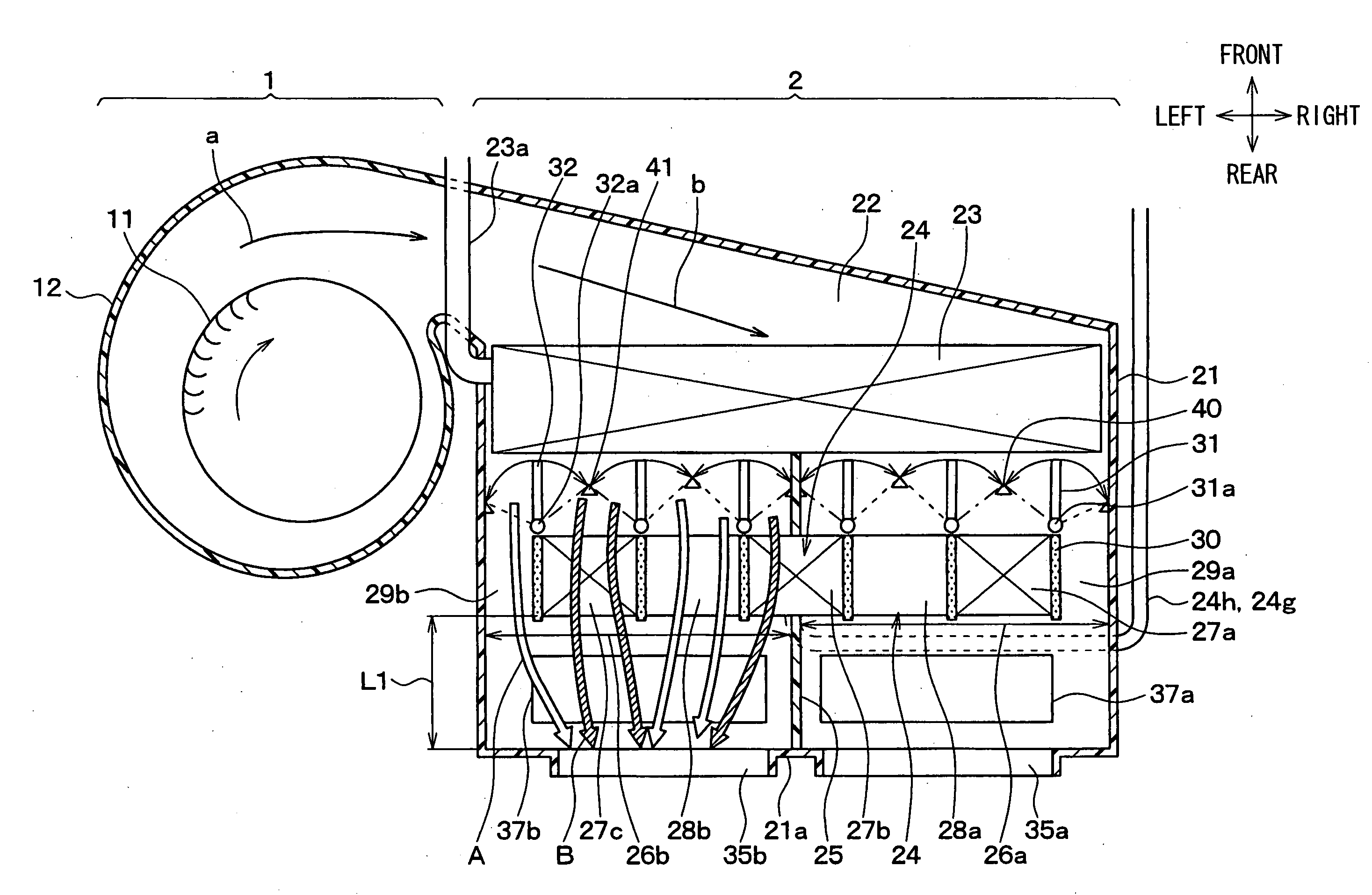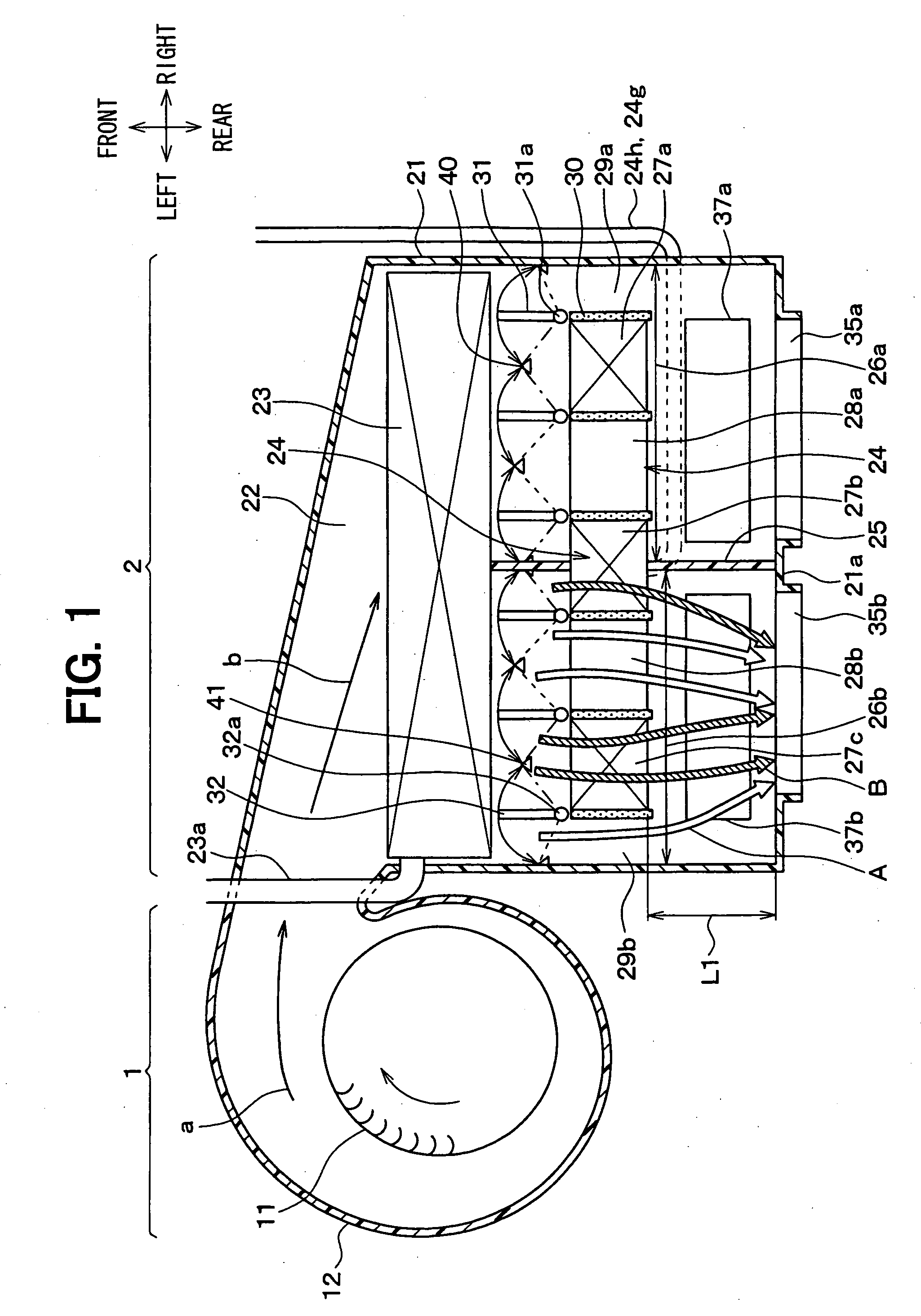Heat exchanger and air conditioner
a technology of heat exchanger and air conditioner, which is applied in the field of air conditioner, can solve the problems of increasing the temperature increasing the pressure loss of air flow, and increasing the variation of air blown into the vehicle compartment. it can avoid the increase of the pressure loss of air flow, and enhance the degree of mixing of cold air
- Summary
- Abstract
- Description
- Claims
- Application Information
AI Technical Summary
Benefits of technology
Problems solved by technology
Method used
Image
Examples
first embodiment
[0034] As shown in FIG. 1, an interior unit of an air conditioner for a vehicle is located in a vehicle compartment, and is broadly divided into tow parts of a blower unit 1 and an air conditioning unit 2 in this embodiment. The air conditioning unit 2 is located nearly in a center area in the right and left direction of the vehicle inside an instrument panel (dashboard) on the front of the vehicle compartment.
[0035] In contrast to this, the blower unit 1 is arranged offset to a position on the front of a front passenger's seat, that is, to a side of the air conditioning unit 2 in the right and left direction of the vehicle. Here, this embodiment, the air conditioner is typically used for a car with a right-hand steering wheel in which a front passenger's seat is located on the left side of the vehicle.
[0036] The blower unit 1 has a well-known construction including a blower fan 11 made of a centrifugal fan having many blades arranged in the shape of a circular ring, a motor (not ...
second embodiment
[0096]FIG. 6 shows a second embodiment of the present invention. In the second embodiment, the cold air bypass passage 28a of the heater core 24 is formed at only one position in the center area in the direction of the length of the tank, and the heating parts 27a, 27c are formed on both the right and left sides of the cold air bypass passage 28a. The second embodiment is the same in the other points as the first embodiment, so the same parts are denoted by the same reference symbols and their descriptions will be omitted.
[0097] In the second embodiment, at four positions, the cold air is mixed with the hot air and the number of positions at which the cold air is mixed with the hot air is decreased as compared with the first embodiment. However, as compared with the comparative example shown in FIG. 15, the number of positions at which the cold air is mixed with the hot air is doubled, so the degree of mixing of the cold air and the hot air can be enhanced.
[0098] As described in t...
third embodiment
[0099]FIG. 7 shows a third embodiment in which the cold air bypass passage 28a and the heating parts 27a, 27c of the heater core 24 are arranged in the up and down direction. That is, one cold air bypass passage 28a is arranged in the middle (center) in the up and down direction of the heater core 24 and the heating parts 27a, 27c are arranged on both up and down sides of the cold air bypass passage 28a.
[0100] The cold air bypass passage 29a arranged outside of the heater core 24 is formed on the upper side of the upper heating part 27a.
[0101] There are provided three air mixing doors 31 rotated in the up and down direction in association with each other. When these three mixing doors 31 are rotated, the one cold air bypass passage 28a, the two heating parts 27a, 27c, and the one cold air bypass passage 29a arranged outside of the heater core 24 are opened or closed.
[0102] Also in the third embodiment, there are formed three positions where the cold air is mixed with the hot air,...
PUM
 Login to View More
Login to View More Abstract
Description
Claims
Application Information
 Login to View More
Login to View More - R&D
- Intellectual Property
- Life Sciences
- Materials
- Tech Scout
- Unparalleled Data Quality
- Higher Quality Content
- 60% Fewer Hallucinations
Browse by: Latest US Patents, China's latest patents, Technical Efficacy Thesaurus, Application Domain, Technology Topic, Popular Technical Reports.
© 2025 PatSnap. All rights reserved.Legal|Privacy policy|Modern Slavery Act Transparency Statement|Sitemap|About US| Contact US: help@patsnap.com



